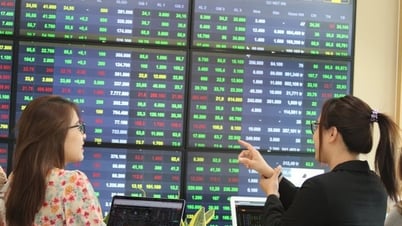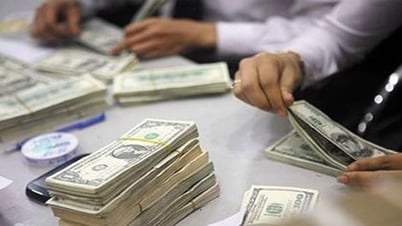The central exchange rate increased by 36 VND, the VN-Index increased by 21.49 points compared to the previous weekend, or the Vietnamese stock market grew positively in the first quarter of 2024... are some notable economic news in the week from April 8-12.
| Economic news review April 10 Economic news review April 11 |
 |
| Economic news review |
Overview
Vietnam's stock market grew positively in the first quarter of 2024, and the growth momentum is expected to continue throughout 2024.
According to information from the Ministry of Finance , in the first quarter of 2024, the VN-Index grew impressively by 13.6% compared to the beginning of the year. This high acceleration rate puts Vietnamese stocks in the top markets in terms of growth rate in the Asian region in the first quarter of 2024. In addition, the margin leverage ratio (margin lending/market capitalization) reached 7.3% by the end of 2023, the second highest in history. The current stock market capitalization is about 6.66 million billion VND, an increase of 12.2% compared to the end of 2023, equivalent to 65.2% of estimated GDP in 2023.
There are currently 736 stocks and fund certificates listed on the 2 Stock Exchanges, 870 stocks registered for trading on the UPCoM floor and nearly 7.4 million securities investment accounts; the average trading value in March 2024 was VND 30.6 trillion/session, up 31.4% over the previous month; the average in the first 3 months of the year was VND 23.7 trillion, up 35% over the average in 2023.
The following factors are considered to support the recent growth of the stock market. The real growth of the economy has many bright spots. According to the first quarter 2024 report of the General Statistics Office, the import and export turnover of goods reached 178 billion USD, up 15.5%, total retail sales of goods and consumer services increased by 8.2% and electricity consumption also recorded a growth rate of more than 10% in the first quarter...
The above positive figures show that the economy is clearly recovering, strengthening the long-term growth momentum of the stock market. Good inflation control is also a factor that creates attractiveness in the eyes of investors. The market is also strengthened by a stable macroeconomy. Although the exchange rate has fluctuated sharply recently, it is still under control. The leader of the State Bank said that with a resource of more than 100 billion USD in foreign exchange reserves, the State Bank is ready to intervene to stabilize the exchange rate when necessary.
In addition, the low interest rate environment when deposit interest rates "hit rock bottom" and the real estate investment channel still has many bottlenecks in the legal progress of projects are also factors that direct cash flow into the stock channel. Monetary policy continues to support credit growth, which is also an important factor supporting the long-term upward trend of the stock market. Many securities companies believe that in 2024, the VN-Index is likely to grow by 20% -25%. With a less positive view, some securities companies forecast a cautious increase of 10% for the whole year.
On December 29, 2023, the Prime Minister issued Decision No. 1726/QD-TTg approving the Strategy for stock market development to 2030 with the goal of: "Developing a stable, safe, healthy, efficient, sustainable, and integrated stock market; enhancing risk tolerance, having a reasonable structure between market components, becoming an important medium- and long-term capital mobilization channel, mainly for the economy; maintaining growth in scale, focusing on improving quality; developing green financial instruments, sustainable finance; promoting digital transformation in the securities sector; building a market management and supervision system associated with the application of modern information technology; strengthening international linkages and integration, gradually narrowing the development gap between the Vietnamese stock market and the stock markets of developed countries".
Experts highly appreciate this move of the Vietnamese Government. At the same time, international experts also believe that the goal of upgrading Vietnam's stock market from frontier to emerging by 2025 according to the stock market classification standards of international organizations is very feasible. Currently, Vietnam has achieved 7/9 mandatory criteria for market upgrade.
Accordingly, there are two issues that need to be resolved for the stock market to be upgraded, which are the requirement for pre-transaction margin and the foreign ownership limit. These two issues need to be studied by relevant Vietnamese agencies soon and solutions proposed to the Government as Vietnam strives to upgrade the stock market before the end of 2025, thereby aiming for the stock market capitalization value to reach 100% of GDP before 2025 and 120% of GDP before 2030.
Domestic market summary week from April 8-12
In the foreign exchange market during the week of April 8-12, the central exchange rate continued to be adjusted by the State Bank in an upward trend. At the end of April 12, the central exchange rate was listed at 24,082 VND/USD, a sharp increase of 36 VND compared to the previous weekend session.
The State Bank of Vietnam (SBV) continues to list the USD buying price at 23,400 VND/USD. The spot selling rate at the end of the week is listed at 25,236 VND/USD, 50 VND lower than the ceiling rate.
The interbank USD-VND exchange rate fluctuated between sessions during the week of April 8-12. At the end of the session on April 12, the interbank exchange rate closed at VND25,020/USD, up another VND60 compared to the previous weekend session.
The dollar-VND exchange rate on the free market fluctuated strongly over the sessions last week. However, at the close of the session on April 12, the free exchange rate only increased by 15 VND in both buying and selling directions compared to the previous weekend session, trading at 25,450 VND/USD and 25,530 VND/USD.
In the interbank money market during the week of April 8-12, interbank VND interest rates fluctuated strongly in all terms. Closing on April 12, interbank VND interest rates were traded around: overnight 4.26% (+1.68 percentage points); 1 week 4.26% (+1.36 percentage points); 2 weeks 4.36% (+1.13 percentage points); 1 month 4.42% (+0.67 percentage points).
Interbank USD interest rates fluctuated slightly up and down across sessions for all terms. On April 12, the interbank USD interest rate closed at: overnight 5.26% (+0.01 percentage point); 1 week 5.32% (+0.01 percentage point); 2 weeks 5.40% (+0.01 percentage point) and 1 month 5.41% (-0.01 percentage point).
In the open market from April 8-12, in the mortgage channel, the State Bank bid for a 7-day term with a volume of VND30,000 billion, with an interest rate of 4.0%. There were VND9,999.99 billion in winning bids and VND8,465.53 billion maturing last week.
The State Bank of Vietnam offered 28-day SBV bills for auction, bidding on interest rates in all sessions. At the end of the week, a total of VND25,250 billion was won, with interest rates increasing from 2.9%/year to 3.5% at the end of the week.
Thus, the State Bank of Vietnam net injected VND 51,283.36 billion into the market last week through the open market channel, the volume of SBV bills in circulation decreased to VND 123,049.9 billion, the volume in circulation on the mortgage channel was at VND 9,999.99 billion.
Bond market: On April 10, the State Treasury successfully mobilized VND7,025 billion/VND10,500 billion of government bonds called for auction (winning rate of 67%). Of which, the 5-year term mobilized the entire VND2,000 billion called for auction, the 10-year term mobilized VND2,500 billion/VND4,500 billion called for auction and the 15-year term mobilized VND2,525 billion/VND3,500 billion called for auction. The 20-year term called for auction of VND500 billion, but there was no winning volume. The winning interest rate for the 5-year term was 1.53% (+0.03 percentage points compared to the previous auction), the 10-year term was 2.48% (+0.03 percentage points), the 15-year term was 2.68% (+0.03 percentage points).
This week, on April 17, the State Treasury offered VND11,000 billion in government bonds, of which VND2,000 billion was offered for the 5-year term, VND4,500 billion for the 10-year term, VND3,500 billion for the 15-year term, and VND1,000 billion for the 30-year term.
The average value of Outright and Repos transactions in the secondary market last week reached VND7,871 billion/session, down from VND9,804 billion/session the previous week. Government bond yields last week continued to increase in most maturities except for the 10-year and 30-year maturities.
At the close of the session on April 12, government bond yields were trading around 1-year 1.79% (+0.02 percentage points compared to the previous session); 2-year 1.80% (+0.02 percentage points); 3-year 1.83% (+0.01 percentage points); 5-year 2.08% (+0.02 percentage points); 7-year 2.28% (+0.01 percentage points); 10-year 2.76% (-0.02 percentage points); 15-year 2.97% (+0.01 percentage points); 30-year 3.11% (unchanged).
In the week of April 8-12, the stock market indices increased and decreased alternately through the sessions, but still ended the week in green. At the end of the session on April 12, VN-Index stood at 1,276.60 points, up 21.49 points (+1.71%) compared to the previous weekend; HNX-Index added 1.66 points (+0.69%) to 241.31 points; UPCom-Index inched up 0.56 points (+0.62%) to 91.21 points.
Market liquidity decreased sharply, reaching an average of nearly VND20,500 billion/session, from VND28,800 billion/session the previous week. Foreign investors continued to net sell more than VND1,335 billion on all three exchanges.
International News
The US Federal Reserve released the minutes of its March meeting, and the country recorded many important economic indicators. In the minutes of the March meeting released on April 11, the Fed reaffirmed that the US economic outlook was stronger than the forecasts made at the end of 2023.
In addition, the effects of tightening monetary policy are lagged and will take time to fully manifest. US economic output is likely to be below potential in 2024, and return to potential in the long run as the effects of monetary policy fade. The unemployment rate is expected to remain largely unchanged over the next few years. Headline and core PCE inflation will continue to decelerate this year.
Core PCE ended the year up about 2.5% year-over-year, as supply and demand in the market gradually moved toward equilibrium. By 2026, both PCE indicators will be close to the 2.0% target. To achieve the inflation target and full employment, the Fed decided to maintain the policy rate at 5.25% - 5.50%, and will carefully evaluate the upcoming data.
The agency does not believe that a cut in the policy rate is appropriate until it has sufficient confidence that inflation is moving sustainably toward its 2.0 percent target, and is prepared to change its stance if risks to achieving that target arise. In the U.S. economy, the headline and core CPI both rose 0.4 percent month-on-month in March, matching the previous month’s increase and beating expectations for a 0.3 percent increase.
Compared to the same period in 2023, the headline CPI increased by 3.5% last month, accelerating from 3.2% in February and surpassing the forecast of 3.4%. This is also the highest CPI compared to the same period in 2023 that the US has received since September 2023.
Next, the US PPI and core PPI both rose 0.2% month-on-month in March after rising 0.6% and 0.3% in February, respectively, in line with forecasts of 0.3% and 0.2%. Compared to the same month in 2023, the PPI and core rose 2.1% and 2.8% respectively last month after rising 1.6% and 2.7% in the previous month.
Finally, the University of Michigan survey said the US consumer confidence index fell to 77.9 points in April from 79.4 points in March, lower than the forecast of 79.0 points.
The European Central Bank (ECB) left its policy rates unchanged at its April meeting. At its meeting on April 11, the ECB said that inflationary pressures in the Eurozone continued to ease due to lower food and commodity prices, but that price pressures in the services sector remained high. The bank is determined to ensure that inflation returns to its medium-term target of 2.0% in a timely manner. The ECB's policy rates are making a positive contribution to the process of cooling inflation.
Accordingly, the ECB decided to keep its policy interest rates, including the refinancing rate, marginal lending rate and deposit rate at 4.50%, 4.75% and 4.0% respectively, unchanged from before. The ECB will not provide any specific roadmap, continuing to rely on data at each meeting to make further decisions. If future factors indicate that inflation is cooling down to the target level in a sustainable manner, a cut in the policy interest rate will become appropriate.
Regarding the Eurozone economy, the Sentix survey said that the Eurozone investment confidence index was -5.9 points in April, up from -10.5 points in March and higher than the forecast of -8.3 points. This is the highest investment confidence recorded in the Eurozone since the war in Ukraine took place in March 2022.
Next, in Germany, the country's industrial output rose 2.1% month-on-month in February, following a 1.3% increase in the previous month and beating the forecast for a slight increase of 0.6%. Compared to the same period in 2023, industrial output in Germany still showed a decline of about 4.9%.
Source link


































































































![[OCOP REVIEW] Tu Duyen Syrup - The essence of herbs from the mountains and forests of Nhu Thanh](https://vphoto.vietnam.vn/thumb/402x226/vietnam/resource/IMAGE/2025/6/5/58ca32fce4ec44039e444fbfae7e75ec)







Comment (0)